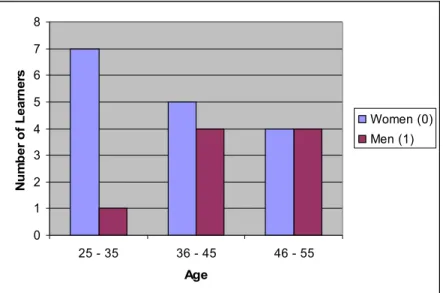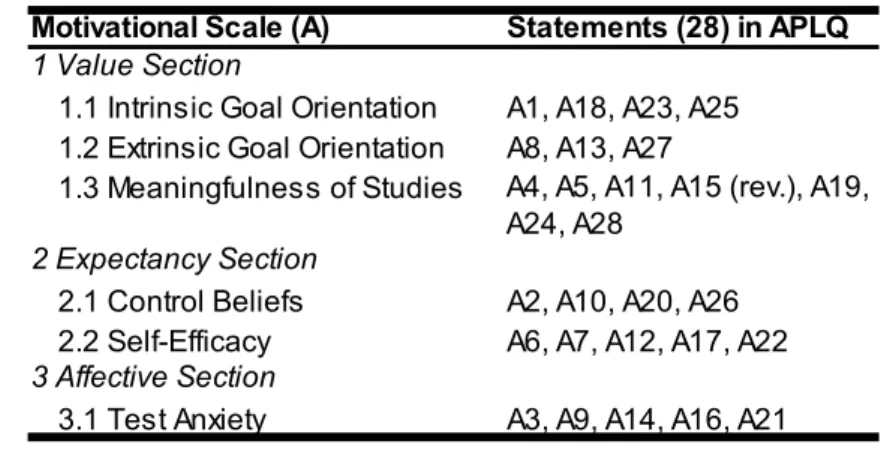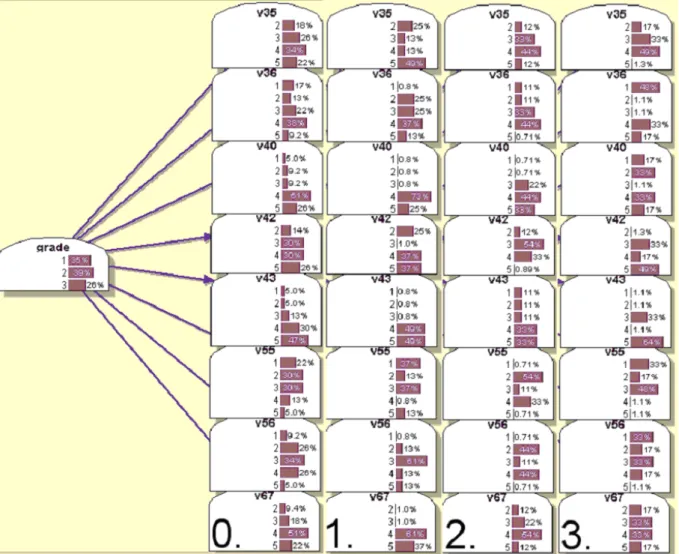The main aim of this research was to further understand the motivational and learning strategies of adult learners. They saw CMC as providing more intense communication than face-to-face groups where the lack of social pressure and the greater freedom to express their opinions without struggling for "the right to be heard" (p. 10) enabled participants to respond to the content, and not the author, with more reflective and effective communication.
Research Questions
Bayesian analysis of the data provided by a questionnaire (Abilities for Professional Learning) to which the research participants responded is an additional methodology. When searching for answers to the research questions, both methods are used to investigate the qualitative variation of the motivation and learning strategies.
Central Concepts of the Research
The term is often used in current research to refer to the type of learning that research participants experienced during the studies that were the subject of the research. In current research, the most commonly used term is online learning environment, which is used to distinguish the currently used learning environment from a general virtual learning environment, which, in some cases, can be used in a classroom with all students present.
Dawn of the New Age
According to Servaes (2002), there were two waves of information society policies in the EU during the 1990s. The second wave came in the latter part of the 1990s, and the focus was then on social aspects of the development of the information society.
Changes to Everyday Life
They continue that if we want the information society to be more than a rhetorical tool, we must develop a more sophisticated appreciation for these social issues: "To this end, while acknowledging the compelling rapidity of change in ICTs and their remarkable rates of diffusion in the past few years, we still have much to learn from consolidating the experience with previous efforts, (Dutel:10ster:2) 7). All these changes in the environment in which today's people live, set enormous demands on their abilities and their willingness to use those abilities to participate in the modern world.
Changes to Work
The employees with individualistic values (found in the USA and Finland) opposed working in teams more than respondents with collectivist values (found in the Philippines and Belgium). Kirkman and Shapiro (ibid.) also note that those respondents who valued power distance (in the Philippines and Finland) reported higher levels of resistance to self-management than those who had low power distance (in the United States and Belgium).
Outside the Society
Other reasons why people are left out of the information society include the cost and perceived complexity of the tools needed to access online services. These kinds of factors are the strongest argument against the utopian view of the information society and its ability to solve social and economic problems.

Modern Learning Theories
Cognitive psychology began to develop in the 1950s with the emergence of the 4 Cs of intrinsic motivation: challenge, curiosity, control, and context (motivation will be discussed in more detail in the next chapter). Social learning theories can be understood as the opposite answer to behaviorism, since learning is supposed to take place by observing the behavior of others, but not by learning from one's own actions and the environment's reactions to them.
Development of the Goal Orientation Theory
Intrinsic and Extrinsic Motivation
In relation to research on how extrinsic rewards influence intrinsic motivation (eg Harackiewicz & Sansone, 2000), it is important to note that intrinsic/extrinsic motivation is not an either-or question. Therefore, it can be argued that a student's intrinsic motivation is not necessarily undermined by the extrinsic rewards that a teacher may provide (grades, praise, or simply approval) (e.g. Lepper & Henderlong, 2000).
Early Goal Theory
Early models of goal theory can be called normative in the sense that they assume that learners can be classified according to the type of academic goal they assume. Furthermore, Zimmerman and Martinez-Pons (1990) found that learners with mastery goals are more likely to use self-regulatory strategies to maintain their interest and motivation in the learning task.
Multiple Goals Theory
In practice, this adds consideration of learner cognition to consideration of achievement goals. Thus, it is possible, and the position of multiple goal theory, that good learning and better outcomes require students to adopt mastery and performance goals (eg Hidi & Harackiewicz, 2000).

Self-Regulation
Phenomenologist View of Self-Regulation
In other words, students' views of themselves and their own value in different contexts, as well as their views of the value of the context and domain to themselves, determine their motivation to use self-regulatory skills in learning. It follows that a prerequisite for the growth of a sense of self-causation is that the student has good self-awareness and self-control skills.
Social Cognitive View of Self-Regulation
To avoid negative evaluation that might threaten their self-efficacy beliefs, they may avoid challenging tasks. If a student is not an expert in the area of a particular task, their self-efficacy statements are more likely to be false.
Definition of Self-Regulation in the Present Study
Instead of abandoning the idea of control beliefs, which is important in the phenomenological perspective, it is included in the APL questionnaire as well as in the qualitative analysis of the research data. It is believed that the interaction between, among others, these two concepts is an important factor in the understanding of learning, especially in social situations.
Premises of Individual Learning
Strategic Capabilities
These strategies involve purposeful use of the material to be learned in a way that it is connected to the learner's prior knowledge, such as using a new unit of vocabulary (a word) in a sentence, or expanding on a topic, building context for it, using one's prior experience or knowledge. As was pointed out at the end of the previous subsection, some strategies, such as questioning, can be used both cognitively and metacognitively.
Motivational Capabilities
They suggest that this is one of the most important learning strategies, as it is the link between motivation and cognition. The relationship between the learner and the task is reciprocal in nature, meaning that while the learner's self-efficacy beliefs influence the choice of the task, the progress they make on the task also influences their self-efficacy beliefs.
Learning in a Group Setting
- Relationship-based Learning
- Social Motivation
- Processes of Group Learning
- Group Development
- Effects of Cooperative Learning
In order for interaction between members of a group to develop, it is important that group relationships foster interdependence, reciprocity, and reciprocity (Fletcher, 1996). The fourth stage is performing and it is precisely in this stage that the productivity of the group is at its highest level.
Technical Development
Modern virtual learning environments offer a range of tools for communication and collaboration for students and teachers. With the development of technology and virtual learning environments, it has become easier for students and teachers to collaborate.

Pedagogical Development
However, one should not make the mistake of thinking that virtual learning environments and distance learning have changed the basic nature of teaching and learning. Virtual learning environments and distance education have not changed the nature of pedagogy, but distance education has placed new demands on teachers' skills and education providers' economics and planning.
Cooperation in Online Environments
Lack of social presence, on the other hand, refers to the fact that virtual environments offer fewer communication channels than face-to-face environments. Media richness refers to the variety and quantity of information available in various media.
Support for Learning in Virtual Environments
Previous research on young learners suggests that most of the facilitator's energy should be directed towards supporting learners' own questioning and feedback activities (eg, Scardamalia & Bereiter, 1992). In fact, it is important that the facilitator makes his/her presence known so that the students do not think they have become adrift in the learning environment.
Collective Online Environment
This term includes the assumptions that the environment is used "online" and that it is used collectively. One might wonder why we use the term collective to refer to the fact that the environment is used by different learners working together.
Research Setting and Participants
Research Setting
During the first meeting, the learners formed five groups of five members each for their group work. It was also during the first face-to-face meeting that the author presented his intention to study the learners and use their experiences as the material for the current study.
Participants
The following figure (Figure 5.2) provides additional information about the learners' genders as they differ in the different age groups. For the purposes of the figure, the age groups used in the previous figure have been combined into a larger whole.

Acquisition of Data
Study Journals
The learners knew that the teachers of the four courses could read the journals when they were written in the work areas of their courses. There were no fixed rules about how much the learners had to write in their journals, or how often.
Abilities for Professional Learning Questionnaire
Metacognition in learning: Students' beliefs about the extent to which they consciously direct (ie, plan, observe, and evaluate) their own learning during study. Resource management: Learners' beliefs about how effectively they use their available time and energy for learning.

Analysis Methods
Phenomenographic Analysis
In the present study, however, the research participants were asked to write study journals in which they reflected on their learning, collaboration, etc. These categories are the result of extensive previous research on the mentioned subject areas and proved to be useful in the categorization of the present research material.
Bayesian Modelling
These descriptions also include information and analysis about the Bayesian analysis of the learners' responses to the APL questionnaire. To ensure the ethics of the current research, this chapter does not provide the names of the learners whose journal entries are cited in the descriptions.
Descriptions of Group Development
- Description of Group 1
- Description of Group 2
- Description of Group 3
- Description of Group 4
- Description of Group 5
However, the distribution of group members in the learning strategies part of the APLQ is clearer. Furthermore, the distribution of group members in the learning strategies part of the APLQ is very homogeneous.
Differences in the Cooperative Performances of the Learner Groups
This part of the analysis also includes the results of the Bayesian analysis of the APL questionnaire. The aim of this part of the study was to identify the most important differences in motivation and learning strategies between excellent, average and underachievers.
Variation in Individual Motivation for Learning
Bayesian Classification Model
The remaining two items belonging to the Test Anxiety and Control Beliefs scale provide less conclusive results, although they show that honors students have less test anxiety (86% answered at the lower end of the scale, i.e. 1 or 2) than the other groups (55% for average and 81% for poor). The control beliefs (v26) of the three achievement groups show relatively similar results at the upper end of the scale, but it should be noted that 33% of low achievers fall at the lower end of the scale, indicating low control beliefs.

Qualitative Variation of Motivation
The few students in the other groups who commented on their beliefs about control were generally also convinced of the effect of their own efforts. The issues raised by the low performers were very similar to those of the medium performers, namely the new terminology and the difficulty of writing.
Summation
However, early in their studies, even some of the high achievers seemed to be intimidated by the sheer number of new terms they had to learn. In the present analysis, the higher optimism of high-achieving students compared to other students was clearly evident.
Variation in Individual Learning Strategies
Bayesian Classification Model
Each of the rows of four boxes represents a different item, or variable, in the APL questionnaire (see Appendix 1). The model shows that high achievers are more likely to look back on their performance and try to find ways to improve it in the future than average and low achievers (98% agreement in the high achiever group, 66% in the average achiever group, and 50% in the low achiever group).

Qualitative Variation of Learning Strategies
The quote shows how detailed some honors students plan to progress their studies. The tone of their diaries differs from that of the more excellent ones, as the statements of the average achievers were somewhat less hopeful.
Summation
Regarding the importance of cognitive strategies, the qualitative analysis found strong evidence that the high achievers used a wide range of such strategies, while the low achievers did not mention them. Nevertheless, somewhat contrary to the prediction of APLQ scores, high achievers also reported high levels of use of all three metacognitive learning strategies covered by the APLQ.
Collective Motivation and Learning Strategies
Collective Motivation
Taken as an example, both high achievers in Group 1 (Section 6.1.1) described how they had worked hard to get the other members of their group to participate more in group work. This seems to indicate that the high achievers ultimately had a positive effect on the goal orientation of the other group members.
Collective Learning Strategies
In analyzing learners' references to collective learning strategies, the author came to the following classification. According to the analysis of the investigative journals, the average performers did not show a strong drive to seek feedback for their own work.
High Achievers as Group Workers
In other words, although the collective learning strategies of the high achievers were highly developed, they were not always so collectively motivated. Overall, five new categories for collective learning were discovered in the analysis of students' study journals.

Factors that Affect Learning in a Group Setting
In the present research, this background has translated into two of the factors in the collective motivation category: social foundation and social support. Background theory also suggested that student groups share some of the same characteristics with individual students (subsection 3.5.2).
Model of Collective Learning
The next chapter (Chapter 9) will further explore some of these issues, as well as the reliability of the current study. Another result of the present study was the data on the qualitative variation of both individual and collective factors of motivation and learning strategies.


